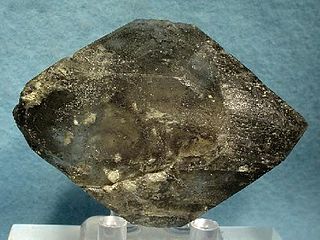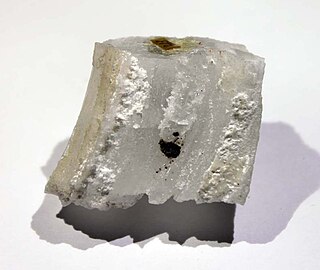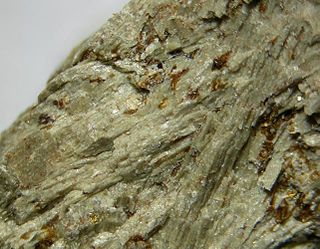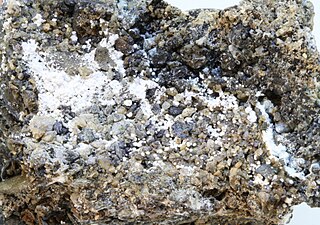
Lazurite is a tectosilicate mineral with sulfate, sulfur and chloride with formula (Na,Ca)8[(S,Cl,SO4,OH)2|(Al6Si6O24)]. It is a feldspathoid and a member of the sodalite group. Lazurite crystallizes in the isometric system although well‐formed crystals are rare. It is usually massive and forms the bulk of the gemstone lapis lazuli.

Melanterite is a mineral form of hydrous iron(II) sulfate: FeSO4·7H2O. It is the iron analogue of the copper sulfate chalcanthite. It alters to siderotil by loss of water. It is a secondary sulfate mineral which forms from the oxidation of primary sulfide minerals such as pyrite and marcasite in the near-surface environment. It often occurs as a post mine encrustation on old underground mine surfaces. It also occurs in coal and lignite seams exposed to humid air and as a rare sublimate phase around volcanic fumaroles. Associated minerals include pisanite, chalcanthite, epsomite, pickeringite, halotrichite and other sulfate minerals.

Blödite or bloedite is a hydrated sodium magnesium sulfate mineral with formula: Na2Mg(SO4)2·4H2O. The mineral is clear to yellow in color often darkened by inclusions and forms monoclinic crystals.

Kalinite is a mineral composed of hydrated potassium aluminium sulfate. It is a fibrous monoclinic alum, distinct from isometric potassium alum, named in 1868. Its name comes from kalium which is the Latin name for potassium, hence its chemical symbol, "K".

Lithiophilite is a mineral containing the element lithium. It is lithium manganese(II) phosphate with chemical formula LiMnPO4. It occurs in pegmatites often associated with triphylite, the iron end member in a solid solution series. The mineral with intermediate composition is known as sicklerite and has the chemical formula Li(Mn,Fe)PO4). The name lithiophilite is derived from the Greek philos (φιλός) "friend," as lithiophilite is usually found with lithium.

Mendozite is a sulfate mineral, one of the alum series, with formula NaAl(SO4)2·11H2O. It is a hydrated form of sodium aluminium sulfate (soda alum).

Aliettite is a complex phyllosilicate mineral of the smectite group with a formula of (Ca0.2Mg6(Si,Al)8O20(OH)4·4H2O) or [Mg3Si4O10(OH)2](Ca0.5,Na)0.33(Al,Mg,Fe2+)2–3(Si,Al)4O10(OH)2·n(H2O).

Millosevichite is a rare sulfate mineral with the chemical formula Al2(SO4)3. Aluminium is often substituted by iron. It forms finely crystalline and often porous masses.
Sulfate crust is a zone observed in the axial (central) parts of burning coal dumps and related sites. It is a zone built mainly by anhydrous sulfate minerals, such as godovikovite and millosevichite. The outer zone can easily be hydrated giving rise to minerals like tschermigite and alunogen. The zone forms due to interaction with hot (even around 600 °C) coal-derived gases (mainly NH3 and SO3) with the "sterile" material (i.e. shales and other rocks serving as the source of Al3+, Fe3+, Ca2+ and other cations) in case of the lack of vents for the gases to escape into the atmosphere.
Efremovite is a rare ammonium sulfate mineral with the chemical formula: (NH4)2Mg2(SO4)3. It is a white to gray cubic mineral. This anhydrous sulfate occurs as constituent in sulfate crusts of burning coal dumps. It is hygroscopic and when exposed to humid air it slowly converts to the hydrate form, boussingaultite.
Boussingaultite is a rare ammonium magnesium hydrated sulfate mineral of the chemical formula: (NH4)2Mg(SO4)2 · 6 H2O. The formula of boussingaultite is that of Tutton's salts type. It was originally described from geothermal fields in Tuscany, Italy, where it occurs together with its iron analogue mohrite, but is more commonly found on burning coal dumps. The mineral possess monoclinic symmetry and forms clear, often rounded crystals.

Beudandite is a secondary mineral occurring in the oxidized zones of polymetallic deposits. It is a lead, iron, arsenate, sulfate with endmember formula: PbFe3(OH)6SO4AsO4.
Grandreefite is a rare secondary lead sulfate-fluoride mineral with a general chemical formula, Pb2SO4F2. It is named for the location in which it was discovered in 1989, the Grand Reef Mine in Graham County, Arizona.

Fluorellestadite is a rare nesosilicate of calcium, with sulfate and fluorine, with the chemical formula Ca10(SiO4)3(SO4)3F2. It is a member of the apatite group, and forms a series with hydroxylellestadite.

Hambergite (Be2BO3OH) is a beryllium borate mineral named after Swedish explorer and mineralogist Axel Hamberg (1863–1933). The mineral occurs as white or colorless orthorhombic crystals.

Aplowite is a very rare mineral with the formula CoSO4•4H2O, a naturally occurring cobalt(II) sulfate tetrahydrate. It is the lower hydrate when compared to bieberite (heptahydrate) and moorhouseite (hexahydrate), and a higher hydrate when compared to cobaltkieserite (monohydrate). It occurs together with moorhouseite within efflorescences.

Felsőbányaite or basaluminite is a hydrated aluminium sulfate mineral with formula: Al4(SO4)(OH)10·4H2O. It is a rare white to pale yellow mineral which typically occurs as globular masses and incrustations or as minute rhombic crystals. It crystallizes in the monoclinic crystal system.
Belakovskiite is a very rare uranium mineral with the formula Na7(UO2)(SO4)4(SO3OH)(H2O)3. It is interesting in being a natural uranyl salt with hydrosulfate anion, a feature shared with meisserite. Other chemically related minerals include fermiite, oppenheimerite, natrozippeite and plášilite. Most of these uranyl sulfate minerals was originally found in the Blue Lizard mine, San Juan County, Utah, US. The mineral is named after Russian mineralogist Dmitry Ilych Belakovskiy.
Meisserite is a very rare uranium mineral with the formula Na5(UO2)(SO4)3(SO3OH)(H2O). It is interesting in being a natural uranyl salt with hydrosulfate (hydroxysulfate) anion, a feature shared with belakovskiite. Other chemically related minerals include fermiite, oppenheimerite, natrozippeite and plášilite. Most of these uranyl sulfate minerals was originally found in the Blue Lizard mine, San Juan County, Utah, USA.The mineral is named after Swiss mineralogist Nicolas Meisser.

Fumarole minerals are minerals which are deposited by fumarole exhalations. They form when gases and compounds desublimate or precipitate out of condensates, forming mineral deposits. They are mostly associated with volcanoes, but have been encountered on burning coal deposits as well. They can be black or multicoloured and are often unstable upon exposure to the atmosphere.














